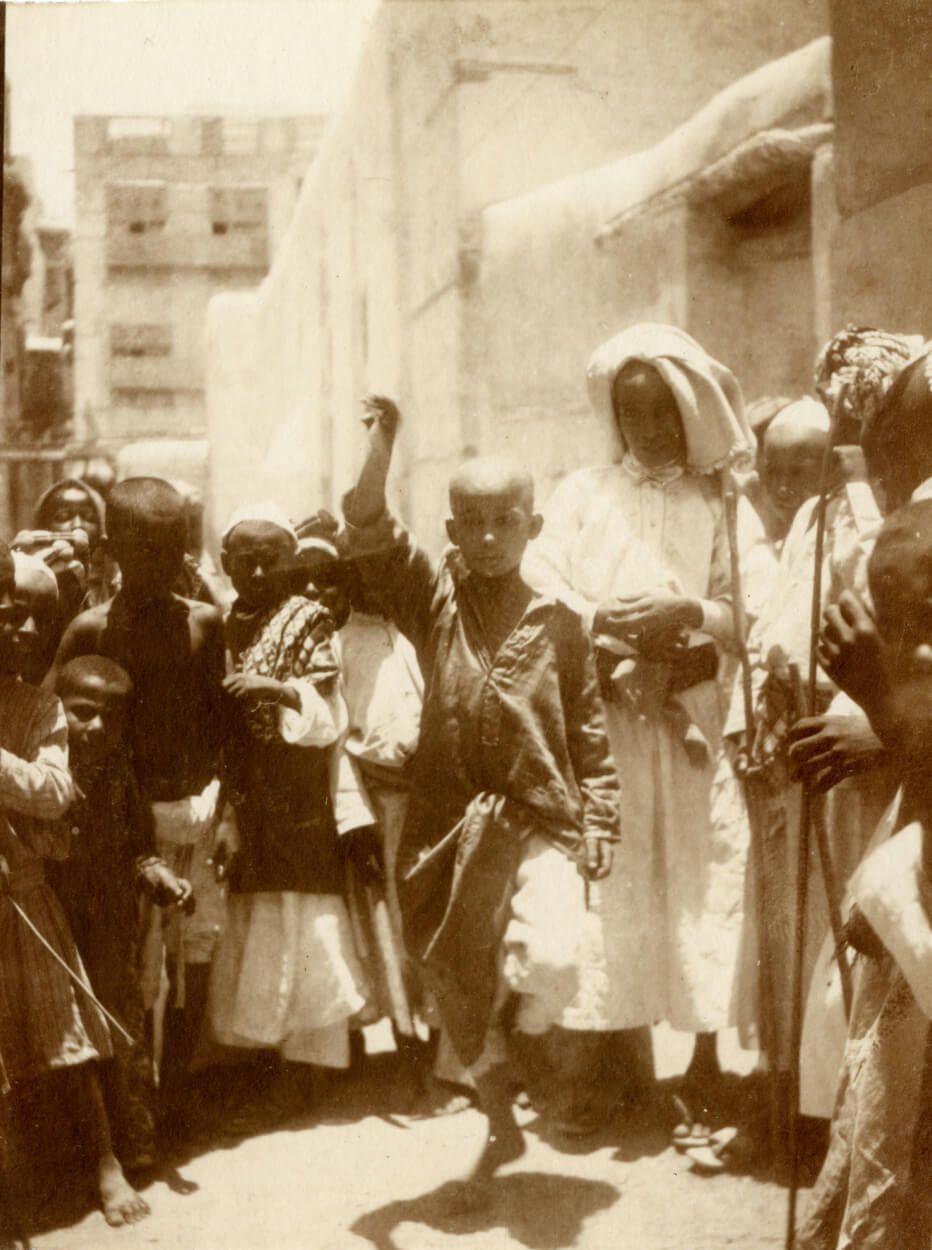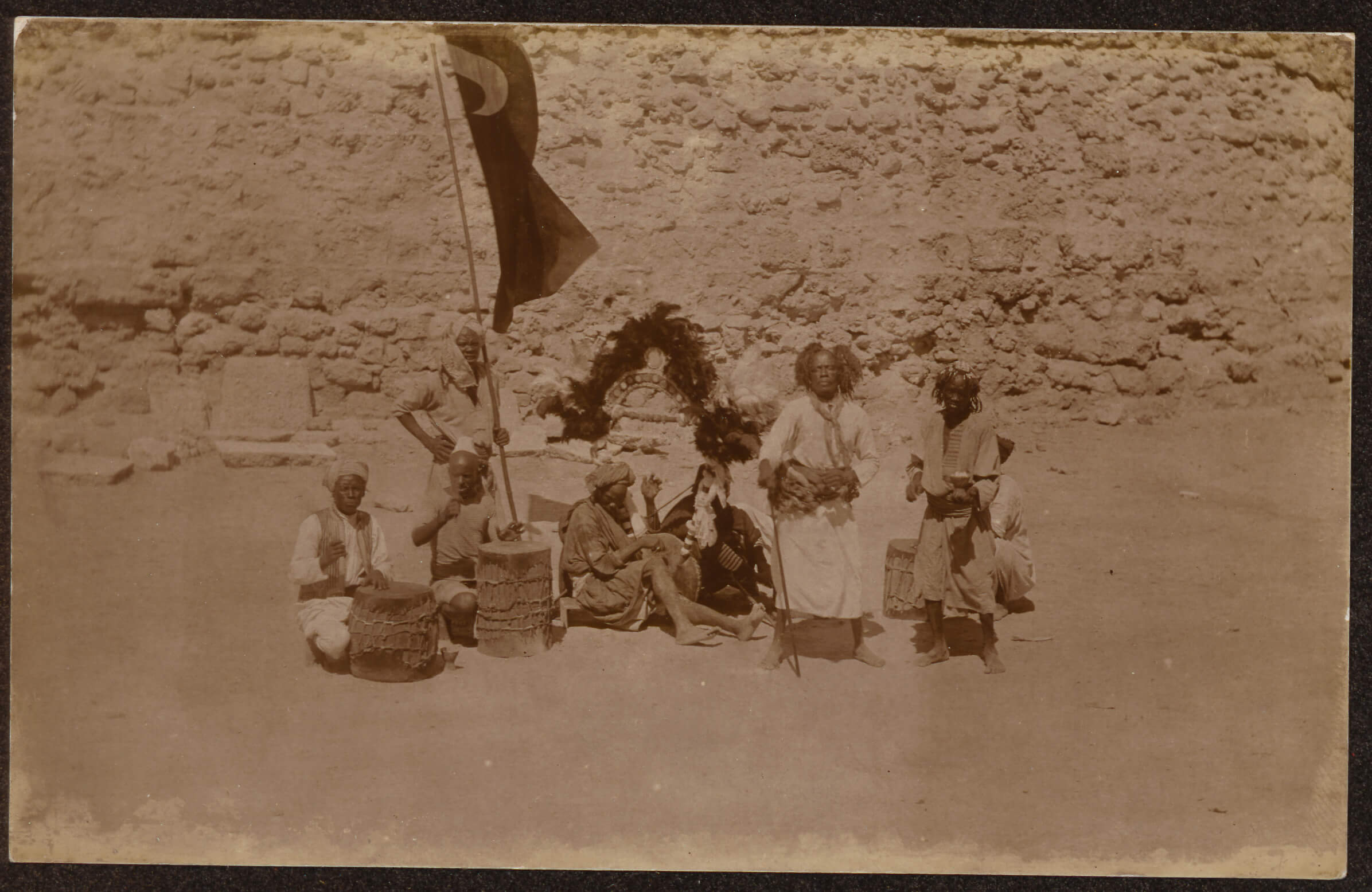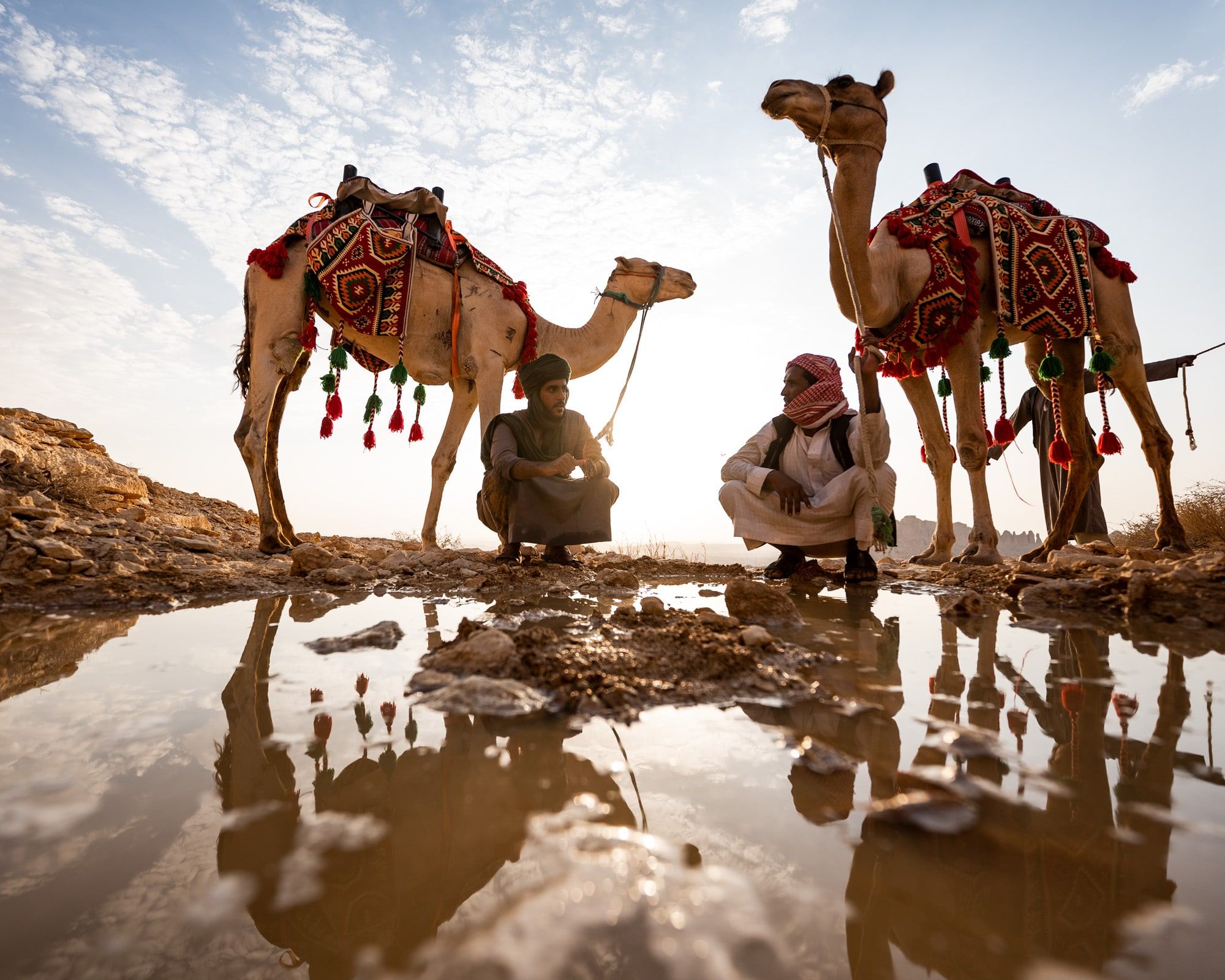The First Recorded Sound of Jeddah
Photograph of a musical recording session in the Dutch Consulate, Jeddah, February 1908, 9x14 cm. Photo courtesy © Leiden University Libraries’ Collection.
Dr. Luitgard Mols, curator and consultant on art from the Arab World.
We all carry certain memories with certain sounds. Some timeless music, like classical pieces by composers long gone, have had generations of listeners, each with their own story associated with a composition.
As we celebrate this elusive yet powerful theme of ‘Sound’, we pay homage to the oldest and often first recordings to come out of a place, that if one listens to, one realizes that not that much has actually changed.
People sang then like they sing today. They prayed, they recited poems and Quranic verses, they celebrated weddings and mourned the dead, and, like us today, simply went about their lives, their voices part of a bigger ongoing symphony of life.
In this special feature, we talk to Dr Luitgard Mols, who curated the exhibition ‘Bait Hulanda – Shared Histories’ that was set up in the old consulate in Jeddah for the Netherlands Embassy in Riyadh and the Saudi Ministry of Culture in Jeddah.
The exhibition featured what is believed to be the oldest recordings of life in Jeddah, dating to 1906 - 1909 CE. Modern-day Saudi Arabia was established on September 23, 1932, by the late King Abdul Aziz bin Abdulrahman Al-Saud.
“The audio recordings on wax rolls were made with an Edison phonograph in the Netherlands Consulate in Jeddah, in c. 1906-1909,” said Dr Mols. “The wax cylinders (about 355 in total that offered about 20 hours of sound) became part of the collection of the Oostersch instituut in Leiden and were donated to the Leiden University Libraries in 1996. The recordings were all transferred to audio CD in the 1990s.”
In the exhibition there were mainly three sound recordings introduced to the visitors “by way of sound showers, all of which were recorded between 1906 to 1909 by Consul Scheltema and Haji Agus Salim in the Netherlands Consulate in Jeddah.”

Photograph of a dancing boy, Jeddah, by C.O. van der Plas, c. 1921–1924, 10x8.5 cm, Snouck Hurgronje collection (1956). Photo courtesy © Leiden University Libraries’ Collection.
1906-1909 CE, wax cylinder B8.
Composed by the Hejazi poet ʿAbd al-Wāḥid al-Jawharī al-Ashram (ca. 1868-1893) and performed by singer Sarāj Qarʿ. He is accompanied by the lute (qanbus) and hand drum (mirwas). This sound was part of a showcase which included an image of a recording session with a lute player, and a phonograph from 1904, which was almost identical to the phonograph that was used during the session.
1906-1909 CE; Songs like these were performed by a female choir when accompanying the bride to the home of the groom. Wax cylinder D20.
“What we observed is that visitors were really listening very attentively to the recordings, moved by what they heard. It is a different experience than looking at old photographs that bring you back to old Jeddah. The combination of the image of the recording session with the lute player sitting in front of the phonograph also added to the experience of listening to the sounds,” she said. “What visitors told me was that the songs and the adhan recording connected you to different parts of your imagination and memories and allowed them to relive an experience of which they were never part, but that the sounds reduce the distance between now and the beginning of the 20th century. As if sounds enabled them to be more intimately connected to a historical place and time.”
It is interesting to understand the reasons behind anyone taking these kinds of recordings, and their priceless contribution to history and our understanding of human evolution. Dr Arnoud Vrolijk, who worked closely with Dr Luit, and is the curator of Oriental Manuscripts and Rare Books, and oversees the Special Collections at Leiden University Libraries, gives us an insight into the history of these recordings, and the role the Dutch scholar of oriental cultures Christiaan Snouck Hurgronje (8 February 1857 – 26 June 1936) had in capturing history.
“It was fairly easy for him to obtain help from the Tadjoedin brothers, travel agents who were active in the transport of pilgrims to Mecca. They saw to it that the phonograph was dispatched to Jeddah together with detailed instructions on how to use it. Snouck’s excellent relations with the Dutch consulate in Jeddah ensured that they were prepared to execute the project for him. It is also important to realize that when Snouck returned to the Netherlands, he was going to be appointed as professor of Arabic at Leiden. Thus, it was only natural for him to develop new plans related to Arabic language and culture. Even on his way home, for instance, he took the initiative to collect modern Arabic proverbs with the help of the tutor of the sons of the Egyptian Khedive,” he said. “Unfortunately, none of these cultural projects bore fruit. Apparently, he was too busy training students at Leiden University for a career in the colonial civil service and advising the Dutch government on colonial policy.”
There is a special relationship we have with sound. It can trigger nostalgic warm feelings when it is a familiar sound of loved ones, where voices change as they age. Sound can inspire awe and curiosity when it is a new one, and then there are sounds we can label as noise. With the ever rising noise pollution in cities, do we ever really get to enjoy the sound of silence?
For Dr. Vrolijk, the recordings have a special meaning to him.
“The human voice is our primary means of communication, giving expression to all our moods, feelings and thoughts. It is also a highly volatile medium, for all sound waves disappear into thin air. It is therefore deeply touching to hear the voices of people who lived more than a century ago, as if they are brought back to life again. And if I am touched by it, then what about people who actually live in Jeddah and Mecca, and now get a chance to hear these voices from their own past again?”

Photograph of tunbura orchestra, Jeddah, by N. Scheltema, c. 1910, 9x14 cm. Photo courtesy © Leiden University Libraries’ Collection.
Dr. Mols, after working diligently on bringing the sounds back to life for everyone to enjoy, hopes there will be more like this project in the future.
“Projects like these are important as they evoke recognition and wonderment at the same time,” she said.
“The people on the images stir memories (actual and those transferred from generation to generation) and allow the visitor to reconnect to the past on a human level. The sounds and moving images allow the visitor, too, to be moved on different emotional levels and connect to the past in new ways. By combining these images and sounds we hope that not only old memories will be revived but new shared narratives and histories will be created."
Dr. Anne van Oostrum, a lecturer of cultural musicology (also known as ‘ethnomusicology’) at the Department of Musicology, University of Amsterdam, studied these recordings extensively and offered us unique insight into the relationship between the recordings and culture in which they were being recorded?
“The majority of the songs collected are accompanied by a qanbus (short-necked pear-shaped lute), in fact poems set to music, and belong to the genre of traditional urban art music of the Arabian Peninsula, called sawt,” she said. “The sawt displays common features throughout the Arabian Peninsula. The lyrics are composed in classical Arabic or in dialect. Second, this genre, also called hejāzī (Saudi Arabia), ‘awādī (Hadramawt) or ghinā’ī san‘ānī (Yemen), shares some common texts and melodies.”
She adds: “In the time of Snouck Hurgronje, friends would pass an evening together listening to the music of the sawt in the diwan, or salon, of a private home. Such a session or private concert was called diwaniya; a solo singer called muqassid, i.e. the performer of the qasida, would accompanied himself on the qanbus. In the course of the twentieth century, this instrument is replaced by the ‘ud, the lute. Other genres also found, such as majrur, and dana, are still much performed in Saudi Arabia, and therefore this historical collection is a treasure trove of poetry and music.”
As someone who not only studies the various levels of music and their connection to history and human stories, Dr Van Oostrum enjoys Arabic music and songs, especially those by the legendary figures like the Egyptian singer Umm Kulthum, the Lebanese singer Fayruz, the Iraqi ud-player Munir Bashir and many other pieces of timeless compositions.
“The tradition of the Arabic music is deeply rooted in the Arabian Peninsula, and singers have always set fine poetry to music…Prior to Islam, the Hejaz had been famous for poetry and music. From the mid-seventh century on, Mecca and Medina became cultural centers of a new genre of art music, when musicians of African, Persian and Byzantine origins influenced the local music.
These people introduced new musical melodies, forms, rhythmical patterns, and instruments. This new genre of art music emerged in the cities of the Hejaz and was performed and later further developed at the courts of the Arab Islamic world,” she said.
“Music is a so-called ‘identity-marker’, in the sense that a person’s musical taste tells you something about his or her identity, think of someone’s generation or somebody’s ethnical background. But music can also serve as a national identity marker, such as the national anthem, or the music performed at special national holidays, or music composed in a specific style by national composers."
There is a lot to be said about music, songs and poetry, as well as the various types of dances in the formation of our story and the stories of our ancestors. As the art of sound evolves, with perhaps Artificial Intelligence taking over more and more, it will be interesting to see what recordings will survive into the future, and what they will say about us in the next 100 years.


